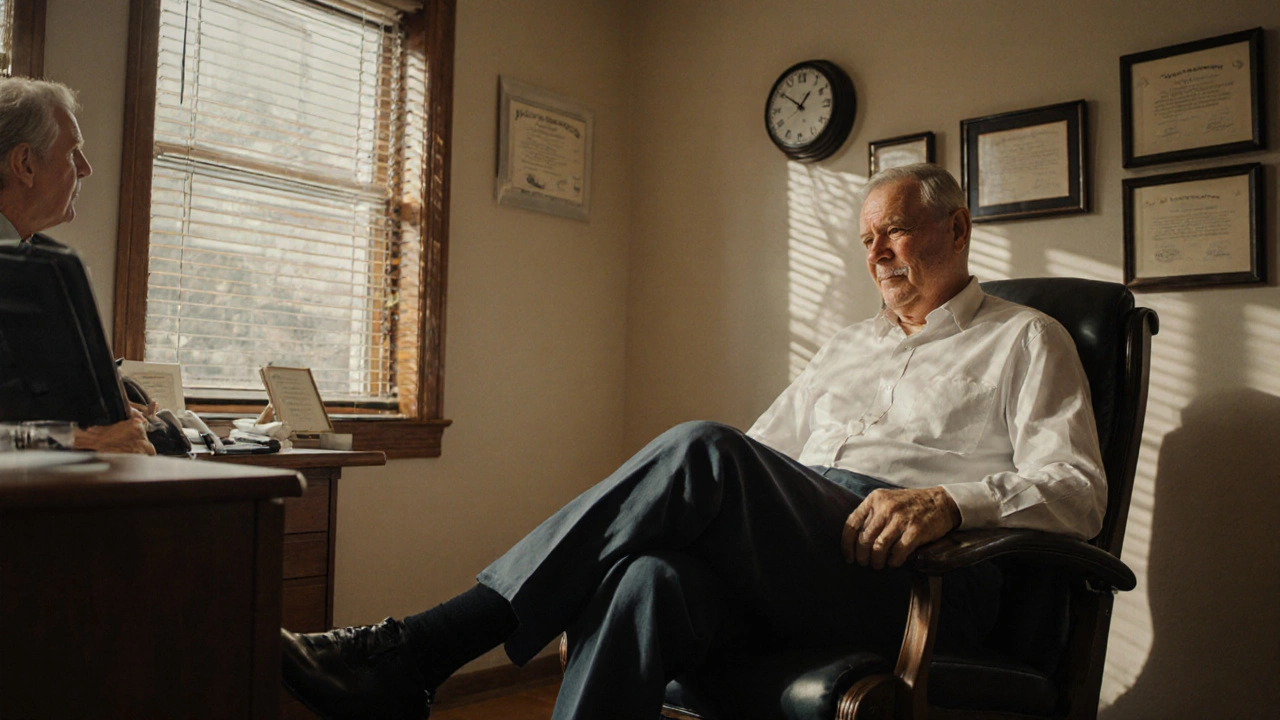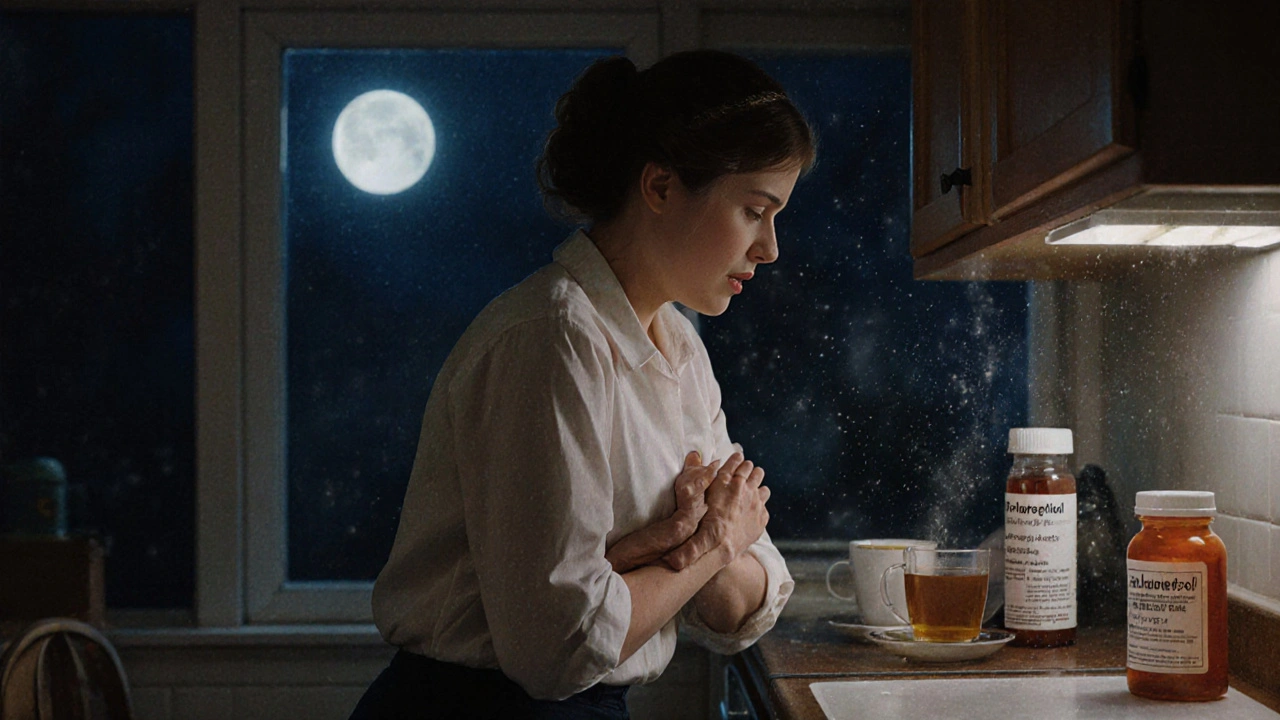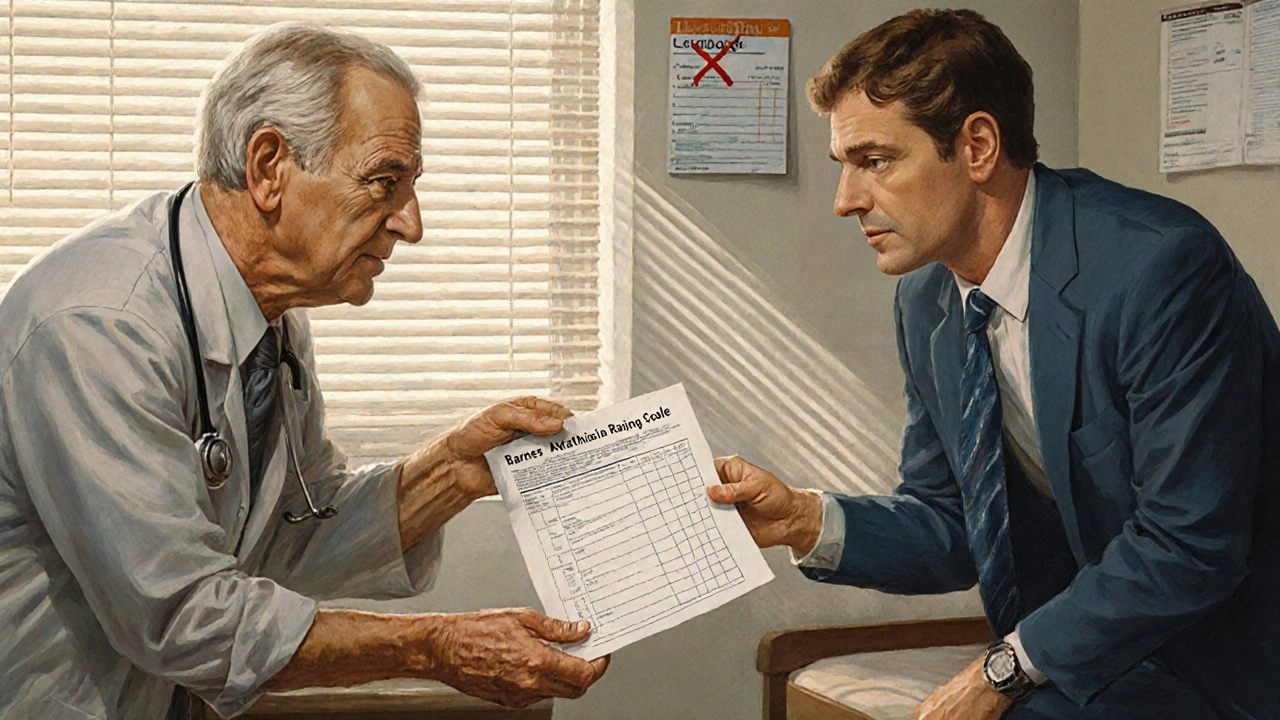Restless Legs and Akathisia from Medications: How to Tell Them Apart and What to Do
 Nov, 27 2025
Nov, 27 2025
When you start a new medication-especially an antipsychotic-you might notice your legs won’t stay still. You can’t sit for more than a minute without shifting, crossing and uncrossing your legs, or pacing in place. Your doctor says it’s anxiety. You’re told to take more of the same drug. But instead of calming down, you feel worse. Inner tension builds until it feels like your skin is crawling. You’re not going crazy. You might have akathisia.
It’s easy to confuse this with restless legs syndrome (RLS). Both make you feel like you need to move. But they’re not the same. And mixing them up can be dangerous.
What Is Akathisia?
Akathisia is a movement disorder caused by certain medications. It’s not just fidgeting. It’s a deep, unbearable urge to move, often described as an internal ache or a feeling that you must escape your own body. The word comes from Greek: a- (not) + kathisis (to sit). You literally can’t sit still.
It’s most common with antipsychotics-especially older ones like haloperidol-but also shows up with metoclopramide (for nausea), some antidepressants, and even anti-nausea drugs. About 20-40% of people on first-generation antipsychotics get it. Even newer ones like risperidone cause it in up to 15% of users.
Unlike anxiety, akathisia isn’t in your head. It’s in your nerves. It’s caused by dopamine blockade in the brain. When dopamine receptors get blocked-especially D2 receptors-your motor system goes haywire. That’s why you feel the need to move, even though you’re exhausted.
How to Spot Akathisia
Here’s what it actually looks like:
- Pacing back and forth, even when you’re told to sit
- Constantly shifting weight from one foot to the other
- Crossing and uncrossing legs repeatedly
- Rocking while seated
- Standing up and sitting down over and over
- Feeling like you need to run or jump out of your skin
These movements aren’t voluntary. They’re compulsive. Patients often say things like: “I feel like I’m going to explode if I don’t move.” Or: “It’s not pain-it’s worse. It’s a scream inside my bones.”
Timing matters. Akathisia usually starts within days to four weeks after starting or increasing a medication. It can also show up after stopping or reducing the dose. That’s called withdrawal akathisia.
How It’s Different From Restless Legs Syndrome (RLS)
RLS feels like crawling, tingling, or pulling in the legs-usually at night or when resting. You get relief by moving. Akathisia feels like an urgent, agitated need to move-no matter the time of day.
| Feature | Akathisia | Restless Legs Syndrome (RLS) |
|---|---|---|
| Onset | Days to 4 weeks after starting medication | Often chronic, may run in families |
| Timing | Worse when sitting, not just at night | Worse at rest, especially evening/night |
| Sensation | Inner restlessness, agitation, distress | Crawling, tingling, aching in legs |
| Relief | Movement helps but doesn’t fully relieve | Movement provides strong relief |
| Trigger | Medications (antipsychotics, metoclopramide) | Iron deficiency, kidney disease, pregnancy |
| Treatment | Stop or reduce drug; propranolol, clonazepam | Dopamine agonists (levodopa, pramipexole) |
Here’s the critical part: Levodopa helps RLS but can make akathisia worse. If you’re on an antipsychotic and your doctor gives you levodopa for “RLS,” you might get much worse. That’s a real risk.

Why Misdiagnosis Is Dangerous
Up to 50% of akathisia cases are misdiagnosed as anxiety, agitation, or psychosis worsening. And when that happens, doctors often increase the antipsychotic dose.
That’s like pouring gasoline on a fire.
Case studies show this leads to suicidal thoughts, aggression, and violence. In one 2017 study from the Royal Australian College of General Practitioners, a patient on haloperidol developed acute suicidal ideation. His doctor thought he was becoming more psychotic. He doubled the dose. The patient nearly died. Only when akathisia was recognized-and the drug stopped-did he recover in 72 hours.
Patients report feeling trapped. One Reddit user wrote: “My doctor kept saying it was anxiety and doubled my Seroquel. I felt like I was going to rip my skin off. I almost jumped out a window.”
The American Psychiatric Association warns: “Failure to diagnose akathisia can be lethal.”
How Doctors Should Check for It
There’s a simple tool called the Barnes Akathisia Rating Scale (BARS). It takes five minutes. It asks two things:
- How intense is your inner restlessness? (0 = none, 3 = severe)
- How much are you moving? (0 = no movement, 3 = constant pacing)
Doctors should also ask: “Do you feel an inner urge to move that you can’t ignore?” and watch for repetitive movements during the visit.
It’s not enough to just ask if you’re “anxious.” You need to ask about movement. And you need to look.

Treatment: What Actually Works
The first step? Stop or reduce the drug causing it. For haloperidol, tapering over 3 days often brings relief. For others, lowering the dose slowly helps.
If you can’t stop the medication-because your psychosis is severe-there are add-on treatments:
- Propranolol (10-60 mg daily): A beta-blocker. Reduces physical agitation. Works for about 60% of people.
- Clonazepam (0.5-2 mg nightly): A benzodiazepine. Calms the nervous system. Very effective, but risk of dependence.
- Cyproheptadine (4 mg daily): An antihistamine that blocks serotonin. Used off-label with good results.
Don’t use dopamine stimulants like levodopa. They make akathisia worse.
There’s new hope too. A 2023 trial showed pimavanserin (a drug for Parkinson’s psychosis) reduced akathisia by 62%. Transcranial magnetic stimulation is being tested at Harvard. And AI tools are being developed to detect movement patterns in video calls.
What You Can Do Right Now
If you’re on an antipsychotic and feel this kind of restlessness:
- Write down exactly what you feel: When? Where? What triggers it? What helps?
- Track when you started or changed your medication.
- Print out the Barnes Akathisia Scale and bring it to your doctor.
- Ask: “Could this be akathisia? Is it possible my meds are causing this?”
- Don’t accept “it’s just anxiety.” Push for movement assessment.
If your doctor dismisses you, ask for a referral to a movement disorder specialist or psychiatrist experienced in medication side effects.
People recover. One patient, Ms. D, described haloperidol withdrawal as: “I was back to myself in three days.” That’s not rare. It’s common-if you get the right diagnosis.
Why This Isn’t Getting Better
Despite being so common, only 37% of U.S. psychiatric clinics screen for akathisia regularly. Most EHR systems don’t even have a checkbox for it. Medical schools barely teach it.
Pharma companies know. Newer drugs like lumateperone (Caplyta) have akathisia rates under 4%. But they’re expensive. Most people still get older, cheaper drugs with higher risks.
Until clinicians learn to see akathisia-not as behavioral problems but as neurological side effects-people will keep suffering. And dying.
This isn’t just about leg movement. It’s about being heard. It’s about not being punished for a side effect with more of the drug that caused it.
Can akathisia go away on its own?
Yes, but only if the triggering medication is reduced or stopped. Akathisia doesn’t resolve with time if you keep taking the drug. In fact, it often gets worse. Most people see improvement within days to weeks after stopping the medication, especially with a slow taper. Never stop antipsychotics abruptly without medical supervision.
Is akathisia the same as anxiety?
No. Anxiety is a mood state-fear, worry, racing thoughts. Akathisia is a movement disorder with physical sensations of inner restlessness and compulsive movement. People with akathisia often feel calm mentally but physically trapped. Treating it as anxiety leads to dangerous increases in antipsychotic doses, which worsens the condition.
Can antidepressants cause akathisia?
Yes. While antipsychotics are the most common cause, SSRIs and SNRIs like fluoxetine, sertraline, and venlafaxine can trigger akathisia, especially when started or increased quickly. It’s less common than with antipsychotics but still happens in up to 10% of users. Always report new restlessness after starting an antidepressant.
What should I do if my doctor won’t believe me?
Bring printed evidence. The Barnes Akathisia Scale, NAMI survey data, and the 2017 RACGP case study are all publicly available. Ask for a referral to a movement disorder specialist or a psychiatrist with experience in medication side effects. If you’re in crisis, go to an emergency department and ask for an evaluation for drug-induced movement disorders.
Are there natural ways to treat akathisia?
There’s no proven natural cure. Vitamin B6 and magnesium have been tried, but evidence is weak. The only reliable treatments are stopping the drug or using medications like propranolol or clonazepam. Avoid herbal supplements that affect dopamine-like L-DOPA from velvet beans-because they can make akathisia worse.
How long does akathisia last?
It depends on the type. Acute akathisia (from new meds) usually resolves in days to weeks after stopping the drug. Chronic akathisia lasts longer than six months and can persist even after stopping. Tardive akathisia can last years. Early recognition and action are key to preventing long-term cases.

Geethu E
November 29, 2025 AT 01:53This hit me right in the chest. I was on risperidone for six months and felt like my bones were screaming. They called it anxiety, doubled my dose, and I almost quit my job. When I finally found a doctor who knew about akathisia, I cried. It wasn’t in my head-it was in my nerves.
jaya sreeraagam
November 29, 2025 AT 09:25Let me tell you something-this is the most accurate breakdown I’ve ever read on akathisia vs RLS. I’m a nurse in a psych ward, and I’ve seen so many patients get misdiagnosed because doctors don’t look for movement, they just listen to ‘agitation.’ The Barnes Scale? I print it out for every new admit now. And yes, levodopa is a trap-don’t let anyone give it to you unless they’ve ruled out akathisia first. Also, propranolol works better than people think-I’ve had patients go from pacing like a caged tiger to sitting calmly in 48 hours. Seriously, this needs to be taught in med school. Like, yesterday.
doug schlenker
November 30, 2025 AT 12:32I had this for three weeks after starting sertraline. No one believed me. My therapist said I was ‘resisting change.’ I felt like I was being crushed from the inside. Took me six months to find a psychiatrist who knew what it was. Now I’m off the med, on propranolol, and I can sit in a chair without wanting to tear my skin off. Thank you for writing this. People need to know they’re not crazy.
Nicola Mari
December 1, 2025 AT 15:44It’s appalling that doctors still treat neurological side effects as behavioral issues. This isn’t ‘anxiety’-it’s a chemical betrayal by the very drugs meant to help. People are dying because clinicians are lazy, arrogant, and unwilling to admit they don’t know what they’re doing. Shame on the pharmaceutical industry for pushing these drugs without proper warnings. And shame on the medical system for letting it continue.
Alexis Mendoza
December 3, 2025 AT 15:44So if your brain’s dopamine is blocked, your body screams to move. That’s wild. Like, your body’s trying to fix a problem your brain can’t see. Makes me wonder how many other things we think are ‘mental’ are actually just nerves screaming because chemistry got messed up.
Chris Kahanic
December 5, 2025 AT 12:45Well-documented and clinically sound. The inclusion of the Barnes Scale and the warning against levodopa is particularly valuable. I have referred this article to three colleagues in my practice. The data on prevalence and misdiagnosis rates are alarming and should be standard knowledge in primary care. Thank you for the thoroughness.
anant ram
December 7, 2025 AT 06:42Guys, I’ve been there-literally. I was on metoclopramide for gastroparesis, and within a week, I couldn’t sit through dinner. I was pacing in the kitchen at 2 a.m., crying because I couldn’t stop moving. My GI doc said, ‘It’s stress.’ I went to a neurologist. He said, ‘Akathisia. Stop the drug.’ I did. 72 hours later, I slept for 12 hours straight. This is real. Don’t let them gaslight you. Print the scale. Bring it. Demand they look at your movements, not just your mood.
king tekken 6
December 8, 2025 AT 15:34lol so you’re telling me the drugs that are supposed to calm you down actually make you feel like you’re being eaten alive from the inside? yeah that’s just big pharma being big pharma. they don’t care if you’re suffering as long as you keep buying. and don’t even get me started on how they bury the side effects in tiny print. i bet they even have a secret handbook called ‘how to ignore akathisia for profit.’ also, i heard the government knows about this and does nothing because they’re in bed with the pharma giants. it’s all connected.
DIVYA YADAV
December 8, 2025 AT 20:55This is exactly what I’ve been saying for years! Western medicine is broken. They give you poison and call it healing. I’m from India, and we’ve known for centuries that the body speaks when the mind is silenced. Akathisia isn’t just a side effect-it’s the soul rejecting foreign chemicals forced into it. And now they want to give you more pills to fix the pills? No. We need to go back to Ayurveda, to natural healing, to listening to the body-not silencing it with more synthetic drugs. The West is blind. They think science is their god, but science is just another tool-and they’re using it to kill people.
Kim Clapper
December 9, 2025 AT 19:59While I appreciate the clinical detail, I must express my profound concern regarding the lack of structural accountability in this piece. The author presents a compelling narrative, yet fails to address the ethical liability of prescribing physicians who continue to misdiagnose akathisia as anxiety despite decades of published literature. Furthermore, the omission of any mention of malpractice litigation or institutional negligence undermines the gravity of the issue. This is not merely a medical oversight-it is a systemic failure requiring legal redress.
Bruce Hennen
December 10, 2025 AT 05:37Incorrect. Akathisia is not caused by dopamine blockade alone. It’s a complex interaction involving serotonin, GABA, and glutamate systems. The Barnes Scale is outdated. Newer studies show that the Kupfer scale is more accurate. Also, propranolol isn’t first-line-clonidine is. And don’t forget that tardive akathisia can be reversed with deep brain stimulation. You’re oversimplifying.
Jake Ruhl
December 10, 2025 AT 21:08so like… what if this is all just a distraction? like… what if the real problem is that we’re all just too wired on screens and sugar and capitalism? i mean, why are we even on these meds in the first place? maybe we don’t need pills… maybe we need to go live in the woods. or meditate. or hug a tree. i tried that after my akathisia started and i felt better. like, i sat outside for 3 hours and just breathed. no meds. no doctors. just me and the wind. maybe the whole system is wrong. not the drug. the world. 🌲
Chuckie Parker
December 10, 2025 AT 22:37